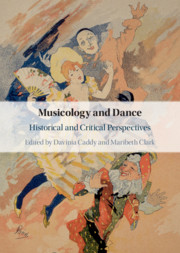Book contents
- Musicology and Dance
- Musicology and Dance
- Copyright page
- Contents
- Figures
- Tables
- Music Examples
- Contributors
- Acknowledgements
- Introduction
- Part I Conceptual Studies
- Chapter 1 Bach and the Dance of Humankind
- Chapter 2 Dance as ‘Other’: Contrasting Modes of Musical Representation
- Chapter 3 Thinking on Our Feet: A Somatic Enquiry into a Haydn Minuet
- Chapter 4 Making Moves in Reception Studies: Music, Listening and Loie Fuller
- Part II Case Histories
- Part III Critical Readings
- Select Bibliography
- Index
Chapter 3 - Thinking on Our Feet: A Somatic Enquiry into a Haydn Minuet
from Part I - Conceptual Studies
Published online by Cambridge University Press: 09 September 2020
- Musicology and Dance
- Musicology and Dance
- Copyright page
- Contents
- Figures
- Tables
- Music Examples
- Contributors
- Acknowledgements
- Introduction
- Part I Conceptual Studies
- Chapter 1 Bach and the Dance of Humankind
- Chapter 2 Dance as ‘Other’: Contrasting Modes of Musical Representation
- Chapter 3 Thinking on Our Feet: A Somatic Enquiry into a Haydn Minuet
- Chapter 4 Making Moves in Reception Studies: Music, Listening and Loie Fuller
- Part II Case Histories
- Part III Critical Readings
- Select Bibliography
- Index
Summary
Joseph Fort ponders a specific case of late eighteenth-century musical embodiment, one that has its origins in social and popular dance: a minuet by Joseph Haydn (Minuet in D major, Hob. IX/11, no. 1), emblematic not of contemporary concert-hall music, but of the music performed in front of a living – and physically mobile – audience at the charity ball held at the Hofburg Redoutensäle in Vienna, 25 November 1792. Reconstructing both the music and the dancing, Fort offers a revealing account of the Vienna dance scene, as well as the minuet’s position within it. More than this, though, he presents a close reading of the interrelations between music and dance from a specifically somatic perspective – one that is deeply intuitive, subjective and sensorial. Realizing his innovative approach alongside similar scholarly attempts at ‘live’ musical embodiment (particularly the work of Elisabeth Le Guin), Fort offers an analysis of the movement that reveals insights into not only the musical score, but also the intrinsically musical and gestural experience of dancing to it.
Keywords
- Type
- Chapter
- Information
- Musicology and DanceHistorical and Critical Perspectives, pp. 71 - 90Publisher: Cambridge University PressPrint publication year: 2020

